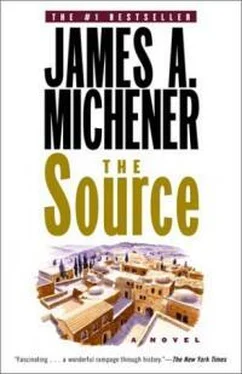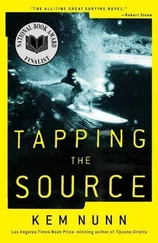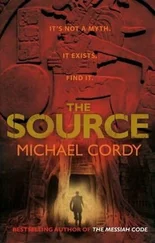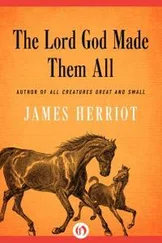Frederick the Second, on the other hand, should have been a calamity but instead succeeded in all he tried. With his knowledge of Muslim ways he coldly surveyed conditions in the Holy Land and quickly decided that it would be a waste of manpower to fight the Muslims, who at this point wanted crusading no more than he did. Therefore, in a series of shrewd negotiations, the German king arranged a truce in which the Christians got everything they had been fighting for: control of the three holy cities of Jerusalem, Bethlehem and Nazareth, with corridors leading to each, plus protection of Christian pilgrims, plus ten years of guaranteed peace. Few Crusaders—no matter how large their armies or their stacks of bezants—had ever gained more; so after only a few months in the Holy Land the green-eyed, humpbacked German went back to Europe, having demonstrated how a war between equals should be conducted.
It’s the damnedest thing, Cullinane reflected, but Frederick’s peaceful negotiations so outraged the knights who had been fighting for a cause that they openly reviled him. “A true knight should not capture Jerusalem without a battle,” they raged. “We should have killed every Muslim in the city.” Others contended that they should have laid waste the countryside and taken many slaves. “God’s blood! We should have marched like men and had an honest clashing of swords.” So impassioned did the outcry become, that when the crook-backed king scuttled out of Acre, citizens lined the streets and threw pigs’ guts at him and cursed him. At one corner they even threw slops over him, for he had done what no leader is allowed to do: by negotiation he had achieved the national purpose, but in doing so had cheated the citizens of an exhilarating war, and for this he could not be forgiven.
• • •
In the early summer of 1290 the position of the Crusaders seemed to improve and a restrained optimism could be felt creeping across the countryside. Crops promised to be above average. Olive oil and wine were being produced in abundance. The Mamelukes were at rest and word reached Acre that the call of Pope Nicholas IV for a Crusade had been ignored throughout Europe, and men could reasonably hope that the present truce would not be disturbed.
When Volkmar of Ma Coeur observed this optimism rising in his principality he dropped his plan for sending his son to Europe. After inspecting the walls of his town and their glacis he concluded, “If some kind of minor trouble does erupt, these outside walls will surely hold for five or six days.” Then he studied the moat and the massive wall which protected the castle itself, and he judged that they could hold for at least half a year, as they had done in the past; their surfaces were as smooth as ever and their outward-sloping bottom sections were as well prepared to ricochet boulders among the attackers. “When the next century comes we’ll be in this castle,” he whispered to himself.
In early July he decided to visit St. Jean d’Acre to see if the leaders of the kingdom agreed with his hopeful assessment, and as he approached the famous city, its towers rising from the sea, his sensation of security increased, for in some mysterious way Acre communicated its strength to all who saw it. Disaster the city had known, but always it had recovered. After his crucial victory a hundred years ago at Hattin, Saladin had taken it; but four years later Richard the Lion Heart had thrown eighty thousand of his men to death against its gates and forced them open. Volkmar felt content that Acre was destined to remain in Crusader hands.
It was a town on a peninsula, surrounded by the sea; its strength came from the sea, and its fortresses stood with their great stone feet in salt water. Across the peninsula ran a massive wall, and the heart of the city was protected by a second. It was the noblest town of the coast, and as Count Volkmar led his party to the iron gate leading beneath the towers his men shouted proudly, “Volkmar of Ma Coeur!” and the ponderous doors swung open to admit the dusty knights to the security of Acre.
But as soon as he entered this stronghold of the Crusaders, Volkmar was hailed by a Venetian merchant, who cried, “Sire, sire! Don’t sell your olive oil this year to the Pisans. They’re robbers.” And he found himself drawn back into that frustrating whirlpool of conflicting interests and cross purposes that characterized Acre in the days of its death. “Oh, God,” he muttered as the angry cries of competing groups reached him. “This city can’t survive another week. We are indeed doomed.”
For in those lovely days, as the Crusades ground to their mournful halt, Acre summarized the reasons why this movement was crumbling in disaster, for few cities in history had been so sorely divided as was Acre in 1290. Nominally it was ruled by the Franks of Henry II, King of Jerusalem, who controlled neither a kingdom nor Jerusalem, but actually it was a sorely divided Italian city, torn by the feuds of Guelph and Ghibelline. The heart of Acre was divided into three commercial quarters, each completely walled off from the other, with its own churches, town hall, magistrates and unique body of law. Each of these Italian areas centered upon its fonduk, a large, open-square warehouse from which the quarter took its name, and from which it maintained an open warfare, featuring soldiers and assassinations, against its competitors. The largest fonduk, running along the eastern waterfront and commanding the best industrial area, belonged to Venice and was subject only to laws promulgated in that Adriatic mother-city, for the functionaries of King Henry were not even allowed inside the walls. In the heart of Acre, well fortified on all sides, stood the fonduk of Genoa, whose residents obeyed only Genoese law. And at the southern tip of the city, enjoying a wind-swept spot along the sea, stood the autonomous fonduk of Pisa. The relationships between the quarters in this critical year of 1290 epitomized a basic weakness of the Crusades: differences in Europe determined behavior in the Holy Land, for in Italy, Genoa had declared war on Pisa, and Venice was maltreating Genoese merchants; so in Acre local Venetians had driven Genoese from the city, and Genoese ships were retaliating by capturing both Venetian and Pisan sailors and selling them to the Mamelukes as slaves. It was war, conducted solely for economic advantage, and if it ever became profitable for the factions to betray Acre to the Mamelukes they would do so without a twinge of conscience.
That was the first division, but not the most important. The city was defended not by a traditional army but by monks who had entered one or another of the military orders—Templar, Hospitaller, Teutonic—and each of these stubborn units was also self-directing, self-paid and dedicated to warfare against the others. The monkish knights who led the orders were permitted to make their own treaties with the Mamelukes and to determine when and how they would do battle. To get all three to agree on any plan of defense was difficult if not hopeless. In Acre each had its own fortified section of the town, not included in the Italian quarters but equally distinct and self-governing; monks and merchants looked at each other with contempt, but since each was essential to the other, a grudging truce was maintained.
The third division, while of lesser importance militarily, was probably of greatest significance where morale was concerned. There were thirty-eight churches in Acre: Latin churches loyal to Rome; Greek Orthodox obedient to Byzantium; Greek Catholics who supported Rome but retained their own rites; and the stubborn, colorful Monophysites who ignored both Rome and Constantinople in their adherence to the old belief that Christ had but one nature. These included the Copts of Africa, the Armenians, and above all the Jacobites of Syria, whose priests made their sign of the cross with one bold finger, proclaiming to the world the oneness of Christ. Among these groups flourished bitter hatreds, with the priests of one confession ignoring or hampering the presence of the others. There were four sets of churches, four rituals, four competing theologies. In any crisis the interests of the four groups were almost sure to be divergent and any hierarchy might try to throw its enemies into confusion or even into the arms of the waiting Mamelukes.
Читать дальше








![Джеймс Купер - Пионеры, или У истоков Саскуиханны [The Pioneers, or The sources of the Susquehannah]](/books/395797/dzhejms-kuper-pionery-ili-u-istokov-saskuihanny-t-thumb.webp)

